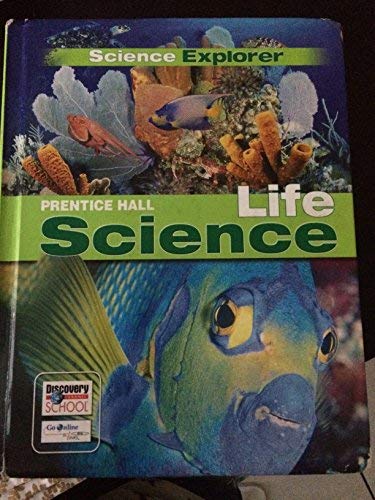-
SCIENCE EXPLORER MOTION, FORCES, AND ENERGY GUIDED READING AND STUDY WORKBOOK 2005
PRENTICE HALL
Paperback (PRENTICE HALL, April 1, 2004)This hands-on content-rich program enables you to lead your students through explorations of specific concepts within Life, Earth, and Physical Science.
-
PRENTICE HALL SCIENCE EXPLORER LIFE SCIENCE STUDENT EDITION 2005
PRENTICE HALL
Hardcover (PRENTICE HALL, Nov. 1, 2004)Science Explorer: Life, Earth, and Physical Science is a comprehensive series that provides a balanced focus of Life, Earth, and Physical Science topics in each book.
-
Prentice Hall Science Explorer: Physical Science
Prentice Hall
Hardcover (Prentice Hall, Nov. 1, 2004)Science Explorer: Life, Earth, and Physical Science is a comprehensive series that provides a balanced focus of Life, Earth, and Physical Science topics in each book.
-
PRENTICE HALL SCIENCE EXPLORER LIFE SCIENCE GUIDED READING AND STUDY WORKBOOK 2005
PRENTICE HALL
Paperback (PRENTICE HALL, April 1, 2005)Science Explorer: Life, Earth, and Physical Science is a comprehensive series that provides a balanced focus of Life, Earth, and Physical Science topics in each book.
-
Exploring the World of Biology: From Mushrooms to Complex Life Forms
John Hudson Tiner
Paperback (Master Books, Jan. 12, 2009)The field of biology focuses on living things, from the smallest microscopic protozoa to the largest mammal. In this book you will read and explore the life of plants, insects, spiders and other arachnids, life in water, reptiles, birds, and mammals, highlighting God's amazing creation. You will learn about the following and so much more:How does biological classification give each different type of plant or animal a unique name?In what ways are seeds spread around the world?What food does the body use for long-term storage of energy?How did biologists learn how the stomach digested food?What plant gave George de Mestral the idea for Velcro?For most of history, biologists used the visible appearance of plants or animals to classify them. They grouped plants or animals with similar-looking features into families. Starting in the 1990s, biologists have extracted DNA and RNA from cells as a guide to how plants or animals should be grouped. Like visual structures, these reveal the underlying design or creation.The newest book in our Exploring series, Exploring the World of Biology is a fascinating look at life - from the smallest proteins and spores, to the complex life systems of humans and animals. W
W
-
Exploring Science: Cameras: With 9 Easy-To-Do Experiments And 230 Exciting Pictures
Chris Oxlade
Hardcover (Armadillo, Dec. 7, 2016)Learn all about the history, science and technology behind cameras from film to digital and recording images, with hands-on projects to try yourself; for 8 to 12-year-olds. R
R
-
Exploring Science: Space An Amazing Fact File and Hands-On Project Book: With 19 Easy-To-Do Experiments And 300 Exciting Pictures
Ian Graham, Geriant H. Jones M.D.
Hardcover (Armadillo, Feb. 7, 2015)This fascinating book takes you on a journey to the Moon, the planets of the solar system and beyond; hands-on experiments show you how to make a dish antenna and simulate solar heat! V
V
-
SCIENCE EXPLORER C2009 LEP STUDENT EDITION EARTH SCIENCE
PRENTICE HALL
Hardcover (PRENTICE HALL, Nov. 15, 2007)Introduction to Earth ScienceMapping Earth's SurfaceMineralsRocksPlate TectonicsEarthquakesVolcanoesWeathering and Soil FormationErosion and DepositionA Trip Through Geologic TimeEnergy ResourcesFresh WaterOcean MotionsOcean ZonesThe AtmosphereWeather FactorsWeather PatternsClimate and Climate ChangeThe Solar SystemStars, Galaxies, and the Universe
-
Science Explorer: Life Science
PRENTICE HALL
Hardcover (PRENTICE HALL, Jan. 15, 2006)Science Explorer: Life, Earth, and Physical Science Life Science Lead author Michael Padilla offers outstanding middle school science content that builds a solid inquiry approach to Life, Earth, and Physical Science. This 3-book series gives you the exceptional features you've come to expect from the Science Explorer program: strong reading support, and multiple opportunities for hands-on inquiry. Whether using the text alone or in a tandem with exceptional ancillaries and technology, teachers can utilize differentiated instruction components to meet the needs of every student at every learning level. Unparalleled technology activates text content and takes science beyond the classroom and into the real world.
-
PRENTICE HALL SCIENCE EXPLORER PHYSICAL SCIENCE GUIDED READING AND STUDY WORKBOOK 2005
PRENTICE HALL
Paperback (PRENTICE HALL, April 1, 2005)Science Explorer: Life, Earth, and Physical Science is a comprehensive series that provides a balanced focus of Life, Earth, and Physical Science topics in each book.
-
Exploring Science: Planet Earth: Continents, Oceans, Climate, Geology; With 19 Easy-To-Do Experiments and 250 Exciting Pictures
John Farndon
Hardcover (Armadillo, Feb. 7, 2015)How was the Earth formed and what is it made up of? Discover the forces that shape the land, with exciting experiments to explain the science. Y
Y
-
Exploring Science: Trains: With 10 Easy-To-Do Experiments And 230 Exciting Pictures
Michael Harris, Steve Parker
Hardcover (Armadillo, Aug. 7, 2016)The history of rail development and travel in a fun-to-follow format, together with technology projects to try yourself, perfect for 8-12 year-olds at home or school. O
O